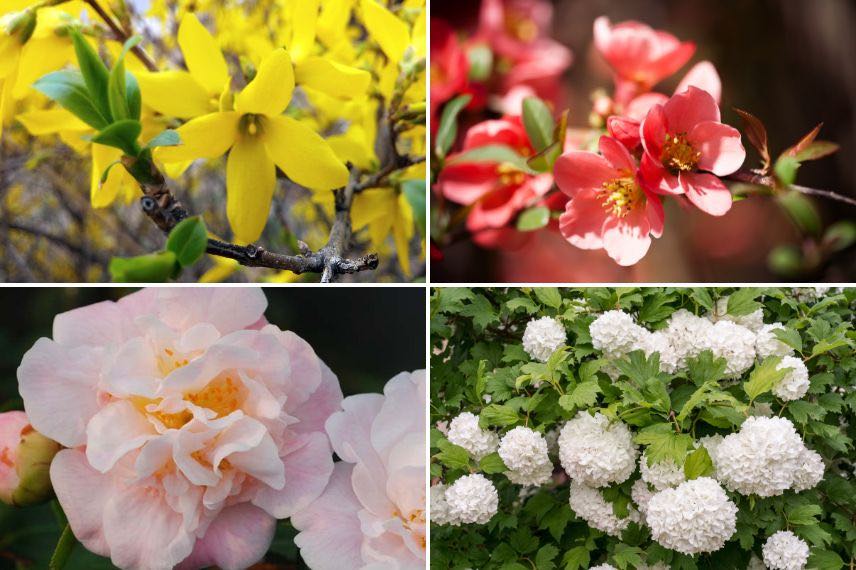
How to prune early-flowering shrubs
Forsythias, Japanese quinces or flowering currants: find out when and how to prune them
Contents
Shrubs that flower early in spring spend winter in dormancy, and it’s during the preceding summer that they develop the buds containing their future flowers. Therefore, to avoid compromising flowering through poor timing, it’s crucial to prune them with this cycle in mind. Discover when and how to prune early-flowering shrubs.

Ribes sanguineum ‘King Edward VII’, flowering in March-April
Which shrubs have early flowering?
Among the shrubs that bloom in March, April or May, you’ll find for example:
- the forsythia,
- the flowering currant,
- the Japanese quince,
- the camellia,
- the deutzia,
- the weigela,
- the snowball viburnum,
- the mock orange.

Forsythia, Japanese quince, ‘High Fragrance’ wild camellia and snowball viburnum
There are exceptions to this specific pruning:
- First of all, ericaceous shrubs such as Azaleas, Rhododendrons, Camellias, Pieris, Andromeda, Witch Hazel, Daphne, Kalmia, Heathers, as well as Holly and Mahonia do not particularly tolerate pruning. However, removing some overcrowded, broken or too old branches is always possible, as well as occasional thinning of the entire shrub. Additionally, to densify the shrub, it may also be necessary to prune it at the beginning of its growth.
- Secondly, evergreen shrubs used for hedges, where spring flowering is not necessarily desired (such as Photinia, Cherry Laurel, Portuguese Laurel, etc.) can be pruned two to three times a year if their growth is considered excessive.
Please note however: The European Parliament Regulation requires member states to take measures on “the prohibition of hedge and tree trimming during the bird breeding and nesting season”. We therefore recommend to avoid pruning your hedges between 15 March and 31 July. Given the biodiversity collapse we are witnessing today, it is important for everyone to act in favour of conservation, particularly for insects and birds.
Read also
Forsythia: Planting, Pruning and CareWhen to prune them?
To ensure abundant flowering year after year, pruning spring-flowering shrubs is necessary as soon as flowering has finished. If you delay pruning for too long after flowering (no later than mid-June for forsythia, July for mock orange), the shrub won’t have enough time to produce new shoots with buds before vegetative growth ceases.
Carry out this pruning in April for forsythia, flowering currant, Japanese quince, and camellia. Prune in May for lilac and spring spirea, and in June for deutzia, weigela, snowball viburnum, mock orange, and photinia. As a general rule, pruning should be done within 1 to 2 months after flowering ends.
→ Remember that each plant profile on our website provides detailed pruning guidance!
How to prune them?
Generally speaking, it involves shortening the stems that have flowered a few centimetres above young shoots or buds, then removing weak branches or those growing towards the centre.
- Completely remove overly thin stems, damaged, twisted or crossing ones to allow light to penetrate the centre of the plant.
- Cut very long flowered stems right back to their base,
- Shorten moderately long flowered stems by 1/3.
- Make angled cuts about 0.5 to 1 cm above a leaf or bud.
Which tools to use?
Hedge trimmer or shears or secateurs?
- Shrubs left to grow freely are pruned with hand secateurs, or with curved blade loppers, or even a pruning saw for the thickest branches.
- Hedges are trimmed using shears or hedge trimmers, whether petrol or electric.
Ensure you carry out pruning with well-sharpened tools disinfected with alcohol. This will promote proper wound healing and prevent disease transmission. When removing old wood, the location of the cut doesn’t matter: the plant will respond either by stimulating the development of internal buds that will break through the bark to produce new shoots, or by producing suckers directly from the ground.
- Subscribe!
- Contents

































